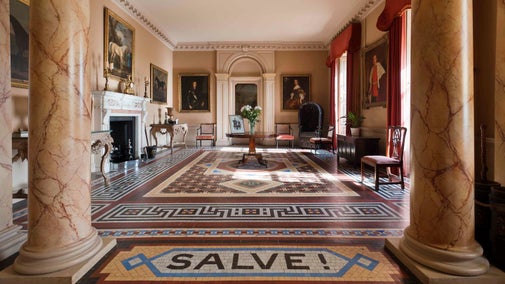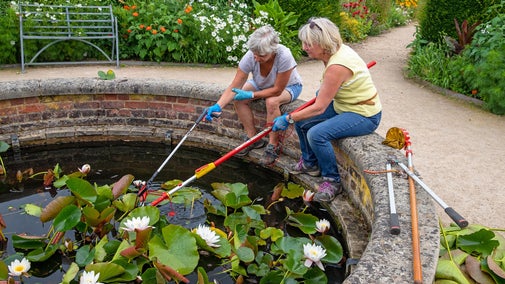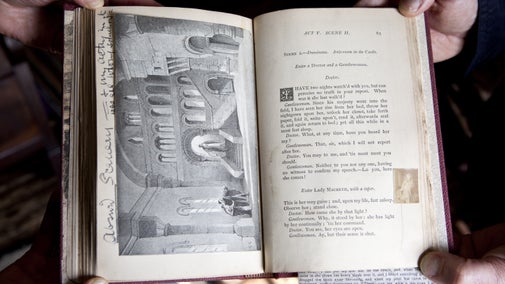
Wimpole Estate's collections
Explore the objects and works of art we care for at Wimpole Estate on the National Trust Collections website.

Wimpole has been continuously occupied for at least 2,000 years with evidence from Roman, Anglo Saxon and medieval times. It’s been owned by a number of different families. The earliest maps show a four-gabled manor house surrounded by a moat. Discover how each of its owners left their mark.
Wimpole is part of an ancient landscape, a recent archaeological excavation revealing a Late Iron Age to Early Roman (100 BC–AD 150) rural settlement.
The remains were extremely dense, representing several phases of changing land use over a few hundred years; two roundhouses were revealed, one with its central hearth intact with livestock enclosures, farming plots and evidence of settlement reorganisation.
The Chicheley family dominated Wimpole for 250 years from 1428. The gabled manor house was demolished and parts of the house you see today were built in the 1640s–50s by Thomas Chicheley, MP for Cambridgeshire and member of the Royalist army. Debts forced him to sell Wimpole in 1686.
Sir John Cutler bought Wimpole from fellow grocer Thomas Chicheley in 1686, and owned it until his death in 1693.
Radnor gained Wimpole through marriage to Elizabeth Cutler, who married without her father’s consent, but he bequeathed Wimpole to her on his deathbed.
Elizabeth died in 1697 and Radnor used her fortune to turn Wimpole into one of the great gardens and houses of the age. Financial strain forced him to sell the estate in 1710.
Newcastle only enjoyed ownership of Wimpole for a short while before he died in a riding accident, leaving his only child Lady Herietta Cavendish-Holles as principal heiress.
Harley gained Wimpole through marriage to Lady Henrietta Cavendish-Holles and set about enlarging the house. An obsessive collector, by the end of his life he had collected vast amounts of books, prints and pamphlets. The manuscript collection was acquired for the nation in 1753, forming the foundation of the British Library. He amassed huge debts and had to sell the estate.

The 1st Earl of Hardwicke and Lord Chancellor bought Wimpole in 1739. He rebuilt the north and south fronts of the house in red brick with Portland stone dressings. Harley's cabinet rooms were made into one ground floor gallery for his prodigious picture collection.
As Attorney-General (1724–34) Yorke is remembered for issuing the 1729 ‘Yorke-Talbot Opinion’ with Charles Talbot (1685–1737), Solicitor General. It was prompted by debate about the status of enslaved people arriving in Britain from the West Indies and inconsistencies between English law and those of its colonies on their rights. The Yorke-Talbot legal opinion stated that enslaved people brought to Britain continued to be enslaved on British soil and that they could be forcibly returned to the colonies at the will of their owner.
Furthermore, they could not become free through Christian baptism. Ruled in law in 1729, Yorke and Talbot oiled the wheels for bounty hunters capturing escapees and it was later described as a ‘Bill of Rights’ for slavery in Britain. Their ruling was overturned in 1772 by the Somerset decision of Yorke’s mentee William Murray, 1st Earl of Mansfield in the Somerset v. Stewart case of 1772 that prevented the forcible removal of an enslaved person from England.
The 1st Earl’s son maintained his father’s colonial interests and became legal counsel for the East India Company (EIC). He was promoted to Solicitor General, and later also to Attorney-General; in 1756 he put his name to another legal opinion, this the Pratt-Yorke, which upheld the rights to ownership of land plundered or acquired by the EIC in India. It had major consequences for the colonisation of indigenous lands in North America.
The 2nd Earl of Hardwicke (1720–90) was more interested in books and manuscripts than political matters, so Wimpole once again became the centre of a great book and manuscript collection. It was the 2nd Earl who, in the 1760s, commissioned 'Capability' Brown to landscape the north park including the building of a gothic tower and serpentine lakes crossed by a 'Chinese' bridge.
A politician with an interest in architecture and agricultural improvement. Uniting these interests, in 1790, he commissioned Sir John Soane, a celebrated architect, to make dramatic alterations to the interior of the house including the Yellow Drawing Room, Bath House and the Book Room and to build a model farm.
Also known as 'Old Blowhard', he became the 4th Earl in 1834. With rigorous efficiency he regulated the estate finances. Changes to the house and gardens included the new servant wing, giant conservatory and new stable block. He even founded an estate fire brigade. He entertained Queen Victoria and Prince Albert for two days in 1843.
An inveterate gambler in the circle of the Prince of Wales and was known as 'Champagne Charlie' after his death. He amassed huge debts, and Wimpole was put up for sale but failed to find a buyer. Lord Robartes took over the house and estate.
Lord Robartes, the sixth Viscount Clifden, took over Wimpole from Charles Yorke and settled Wimpole on his son Gerald in 1906. The maintenance of Lanhydrock and Wimpole proved too expensive, and Gerald Agar Robartes, the 7th Viscount Clifton moved to Lanhydrock in Cornwall. Wimpole was only occupied occasionally, usually for game shooting, racing at Newmarket or cricket in front of the house.
Captain George and Mrs Elsie Bambridge first rented Wimpole in 1938 and had bought it by 1942. The only surviving child of Rudyard Kipling, Elsie Bambridge was able to use the substantial royalties from her father’s books to refurbish the house.
The house was largely empty of contents, so they set out buying pictures and furniture to fill the house, bringing back many pieces that had once been owned by Wimpole’s previous families.
During the war the household moved into the basements, for safety. Wimpole Estate was requisitioned by the War Office, though due to the lack of mains electricity and the primitive drainage and water supply in the house, only the Servant’s Wing was used.
Captain Bambridge died in 1943 as a result of chill, caught whilst out shooting. As had the previous owners, Mrs Bambridge found difficulty with the scale of work and finance to keep the house and estate in good order.
The east Servant’s Wing and west Orangery wing of the mansion were demolished, as were several other buildings around the estate.
Mrs Bambridge bequeathed the house to the National Trust on her death aged 80 in 1976. Since then, the National Trust has continued her work to restore the gardens, parkland, farm and house.

Explore the objects and works of art we care for at Wimpole Estate on the National Trust Collections website.
Step inside Wimpole Hall and discover how previous owners made their mark on this complex house.

Discover Wimpole’s gardens and visit the Parterre, walk through the Pleasure Grounds meandering your way to the Walled Garden, with herbaceous borders and fruit trees.

Built in 1794, Home Farm is the only in-hand farm of its kind in the National Trust. Unique to Wimpole Estate, it is a model for sustainable farming practices. A must see on your next visit, it is home to many rare-breed animals and the species of flora and fauna that make the estate an agricultural champion.

Discover the opportunities available for volunteering at Wimpole Estate and what you could get out of it.

From events and activities to getting close to animals, here's what you need to know about a family day out at Wimpole.

Brown designed landscapes that fitted in seamlessly with the surrounding countryside. So how do you spot the designs of one of the greatest gardeners of all time?

Learn about people from the past, discover remarkable works of art and brush up on your knowledge of architecture and gardens.
